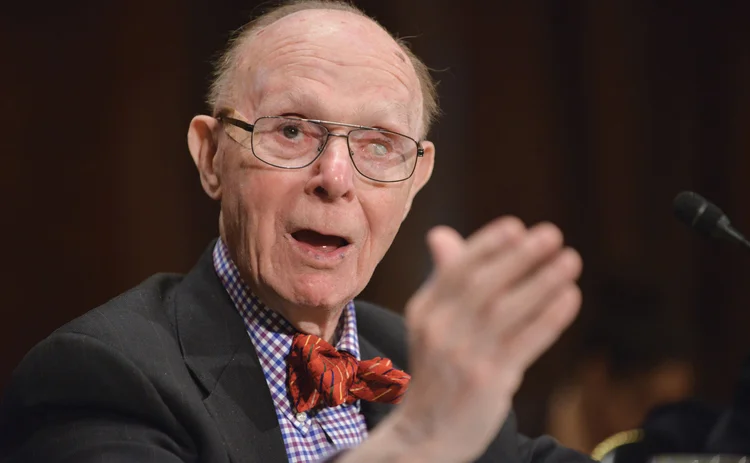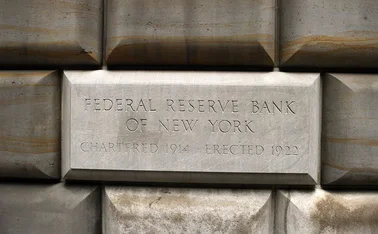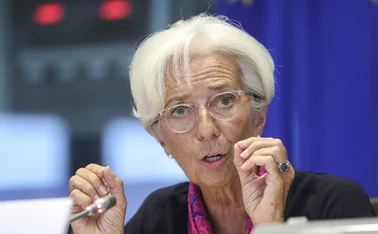
Making the rules and breaking the mould (Allan Meltzer: 1928–2017)
John Taylor writes about economist who defied tradition and had major influence on central bank policy

Allan Meltzer, who died in May at the age of 89, had a long and productive career fundamentally affecting the fields of economics, central banking and economic policy, more broadly. An extraordinary scholar, he immersed himself in the practical world of policymaking in many ways. He had a unique ability to understand, explain and improve the interface between the fields of economics and economic policy.
For Meltzer, it was not enough to develop a novel theory of the economic impact of monetary policy, which he did in his research on the financial system, starting with Swiss economist Karl Brunner. He also examined the institutions responsible for policy through his landmark books A History of the Federal Reserve, volumes 1 and 2, and the Carnegie-Rochester Conference Series on Public Policy, which he co-founded with Brunner.
For Meltzer, it was not sufficient to show empirically that policy mistakes caused poor economic performance. He also researched why the mistakes were made, including by developing theories of political economy and decision-making with Scott Richard and Alex Cukierman. It was also not enough for him to conduct research and teach at Carnegie Mellon University, where he was a professor.
He also threw his hat into the ring of real-world policymaking, serving on the US president’s Council of Economic Advisers (CEA), chairing the Meltzer Commission on international monetary reform, writing reports for Congress, and often testifying in congressional committees on monetary policy.
And it was not even enough for him to have had a profound impact on central banking – he also delved into the operations of the whole market system, asking the key question in the title of his book Why Capitalism? and answering that it is “the only system that the world has ever known that produces both growth and freedom”.
Criticism was never personal
In engaging with actual policy, Meltzer never held back criticism of policy decisions and policymaking institutions, when he felt strong criticism was warranted. But he avoided personal attacks or impugning people’s motives. Regarding US Federal Reserve Board decisions, for example, he wrote in his History that, “although I find many reasons to criticise decisions, I praise the standards and integrity of the principals”.
Meltzer’s views on monetary policy began to take form in his research with Brunner, whom Meltzer noted was his “teacher, dissertation supervisor, later my co-author and lifelong friend”. They wrote 25 papers together on policy, many focused on a model of the monetary transmission process. The modelling research began in the 1960s, and the key framework was later called the Brunner-Meltzer model. Meltzer went on to develop this framework further and apply it in practice.
The model was unique in the way it incorporated the determinants of the supply of money as well as the demand for money, going behind the scenes of the quantity equation of money employed by Irving Fisher and Milton Friedman. The model showed how the economic effects of changes in the money supply involved a complex channel with credit flows, wealth effects, interest rates and asset prices. Today, many macroeconomic researchers are trying to incorporate credit into popular macro models because changes in credit flows had such a noticeable and devastating impact during the Global Financial Crisis. Meltzer had incorporated these features into his thinking 50 years ago.

Based on this theoretical and empirical research, Meltzer came to a particular view of how to evaluate monetary policy, which gave clear advantages of predictable rule-like decisions for the policy instruments, whether the interest rate or the monetary base. He then applied this framework consistently over time to actual policy, uncovering policy mistakes in the midst of policy successes. More than any other monetary economist, he looked for and examined the reasons for the mistakes, and he focused on two basic reasons: political interference with policy; and mistaken beliefs about policy. This led to his recommendations of how central banks should be governed and how monetary policy should be conducted, which have had an important impact.
Fed’s mistakes in the 1930s and 1970s
Meltzer argued that the cause of the Great Depression of the 1930s was largely a mistake made by Fed officials who allowed the money supply – currency and deposits – to fall by 28%. He then looked for the reasons for that mistake, and concluded the problem was mainly a faulty belief at the Fed about how monetary policy works. He found evidence in the Fed’s own records that it had used misleading indicators, such as nominal interest rates or bank borrowings as measures of monetary tightness, when economic theory pointed to the real interest rate and broader monetary aggregates – such as currency and deposits. For this reason, the Fed decided that open market purchases were not necessary because low member bank borrowings and low interest rates were a sign of monetary ease. Meltzer showed that the alternative, correct, view that the central bank should control deposits and currency was known outside the Federal Reserve System at the time, but was not reflected in the Fed’s decisions.
“So certain was the System about the correctness of its actions and its lack of responsibility for the collapse that I have found no evidence the Board undertook an official study of the reasons for the policy failure,” he wrote in the History.
Meltzer also argued that the Great Inflation of the late 1960s and 1970s was due to a policy mistake – this time, a large increase in money growth and a corresponding effort to keep interest rates too low
Meltzer also argued that the Great Inflation of the late 1960s and 1970s was due to a policy mistake – this time, a large increase in money growth and a corresponding effort to keep interest rates too low. Again, Meltzer looked for the reasons for the policy mistake. One reason was the Fed’s mistaken belief in the Phillips curve that said that higher inflation would reduce unemployment permanently. But a second reason was political. The Fed agreed to co-ordinate its actions with the US administration’s fiscal policy – a practice that meant the Fed would try to keep interest rates low. A third reason was also political. As the 1972 election approached, Fed chair Arthur Burns became convinced that the unemployment rate required to reduce inflation would be politically unacceptable. He became the leading proponent of wage and price controls, and let money growth increase. So both of Meltzer’s categories of reasons for mistakes were to blame.
Volcker recaptures lost Fed independence
The end of the Great Inflation and the start of the Great Moderation of price and output stability was a different story. There was an absence of the big mistakes, and a corresponding emphasis on more predictable rule-like behaviour. Meltzer stressed Fed chair Paul Volcker’s reliance on a framework in which inflation is a monetary phenomenon with no long-run Phillips curve trade-off. He emphasised how Volcker recaptured much of the independence the Fed lost during the Great Inflation, and thereby was able to resist political interference and take the necessary steps required to restore stability.
In going deeper, Meltzer wrote how Volcker was ideally suited for preventing the mistakes. Volcker had “the background and experience to be a successful chairman… Foreign central bankers and New York bankers knew him and had confidence in him. He was knowledgeable and strong-willed, and… determined and committed to the task”.
During the Great Moderation, which continued under Volcker and much of Alan Greenspan’s term as chair, the Fed did not succumb to political pressures or faulty theories. Meltzer was again critical of monetary policy for its role in the Global Financial Crisis.

He argued that it was a mistake for the Fed to depart from a rule-like policy and keep rates unusually low in the years before the crisis. The explanation for these policy mistakes appeared to be in the ‘mistaken beliefs’ category – a mistaken view that rule-like policy was not necessary and that a return to discretion was OK. He was also critical of quantitative easing after the crisis, and said that the Fed’s lender-of-last-resort actions during the crisis had no clear strategy. On the political side he argued that the Fed seemed willing to sacrifice much of independence that Volcker restored in the 1980s.
In sum, Meltzer concluded that the Great Depression was mainly due to bad economics: mistaken beliefs about interest rates and bank borrowings; the Great Inflation was a combination of both factors, with political pressures dominating near the end as beliefs changed but policies did not; the Disinflation avoided big mistakes of either type as the Fed regained independence and restored basic monetary fundamentals, which continued into the Great Moderation, a period of more rules-based policy; the Global Financial Crisis and its aftermath was a return to a combination of both kinds of errors. Meltzer’s research thus led him to a clear policy conclusion, as he wrote in the second volume of his History, published in 2010: “Discretionary policy failed in 1929–33, in 1965–80 and now.” And equally clear and convincing is that “the lesson should be less discretion and more rule-like behaviour”. This considered assessment, based on years of research and study, is perhaps his most fundamental contribution to central banking.
It is important to note that the History was itself a “monumental accomplishment”, to use the words of economic historian Michael Bordo. Meltzer examined transcripts of meetings of the Federal Open Market Committee, notes and interviews with Fed officials, records at the New York Fed and other regional banks, papers from presidents of the US and their assistants, records of the Congress, the Treasury, the CEA, foreign monetary officials, academics and journalists. He insisted that policymakers express their views and explain their decisions in their own words, and thus frequent quotes of policymakers are found throughout the History. He connected complex series of events, transforming his painstaking research into “an exceptionally clear story”, as economist David Laidler described it. By making so much information accessible in a readable and manageable form, he contributed greatly to economics and central banking.
Congressional hearings
Meltzer’s work over the years advising Congress and many administrations is another part of his impact on policy. There is no better way to understand this influence than to have watched him in action. I recall a 2015 hearing at the Senate Committee on Banking, Housing, and Urban Affairs about monetary reform, where he was a witness. I sat next to him at the witness table, listening carefully. Meltzer was remarkably clear, articulate and convincing, directly addressing senators on the committee, both Democrats and Republicans. Indeed, both sides seemed to be listening carefully, in part because he was so obviously nonpartisan. In answering a question about a lender-of-last-resort proposal by senator Elizabeth Warren, he said: “I congratulate you, senator Warren, for keeping this issue alive.”

Meltzer spent a lot of time at this hearing explaining the merits of a bill that would require the Fed to describe its rule or strategy for monetary policy. In his opening, Meltzer said: “We need change to improve the oversight that this committee and the House Committee exercises over the Fed. You have the responsibility. Article I, Section 8 gives that to you. But you do not have the ability to exercise authority. You are busy people. You are involved in many issues. The chairperson of the Fed is a person who has devoted his life to monetary policy. There is not any series of questions that you can ask on the fly that they are not going to be able to brush aside. That is why you need a rule.
“I agree with John Taylor about some of the reasons for the rule, but I believe one of the most important is that Congress has to fulfil its obligation to monitor the Fed, and it cannot do that now because the chairman of the Fed can come in here, as Alan Greenspan has said on occasion, Paul Volcker has said on occasion, and they can tell you whatever it is they wish, and it is very hard for you to contradict them. So you need a rule which says, look, you said you were going to do this, and you have not done it. That requires an answer, and that I think is one of the most important reasons why we need some kind of a rule.”
Later in the hearing, senator Sherrod Brown asked: “Dr Meltzer, be specific, if you would, about your thoughts about the audit the Fed proposals.”

Meltzer answered: “Suppose you found out that the Fed chooses its policy using a ouija board. What would you be able to do with that? What you want to do is get something which permits you to see that the policies that are carried out, are carried [out] for the benefit of the public… What I think the Congress needs to do, it needs to face up to its responsibilities. Its responsibility is to be able to say to the Fed: ‘You told us you were going to do this, and you didn’t do it. Why?’ [That’s what] the rule gives you… [That is] more important than any other single thing you can do. You do not have the ability now to monitor them.”
The Meltzer Commission
In 1998, Meltzer was asked to chair the Congress-mandated International Financial Institution Advisory Commission, also known as the Meltzer Commission, to recommend policy and reforms. The commission recommended reforms for the US government to try to implement at the International Monetary Fund and World Bank, including limits on IMF lending and greater emphasis on grants for poor countries, rather than loans that they could not pay back. The actual reforms promoted by the US administration and implemented in the years that immediately followed were heavily influenced by the commission’s recommendations. I can say this with conviction because I served as undersecretary of the Treasury during this period. Examples included the greater emphasis on grants rather than loans from the World Bank and limits on lending from the IMF.
What I think the Congress needs to do, it needs to face up to its responsibilities. Its responsibility is to be able to say to the Fed: ‘You told us you were going to do this, and you didn’t do it. Why?’
Allan Meltzer
When thinking about Meltzer’s important role in chairing the commission, one is reminded of his research and writings on the international side of monetary policy. In the History, he covers the growing US trade deficits in the 1960s and the reluctance to deal with them in a way that might risk slowing economic growth. The result, in his view, was failed policies of capital controls and efforts to twist the yield curve by buying longer-term Treasury securities in ‘Operation Twist’. He also had many sessions on international financial institutions at the Carnegie-Rochester conferences over the years, and was later president of the international Mont Pelerin Society.
Encouraging economists
An important part of Meltzer’s impact was his constructive influence on other economists, and I can say that was certainly true of me. When I was just beginning my career as an economist as an assistant professor at Columbia University in the early 1970s, he started inviting me to attend the Carnegie-Rochester conference in Pittsburgh, Pennsylvania, knowing that it was a city where I was from and my family still lived. He opened a window for me to see serious policy-orientated research and to meet economists and policymakers who were committed to applying this research. In November 1976, he gave me the opportunity to discuss a paper by Ed Prescott, in which Ed explained the policy implications of time inconsistency, which he published a year later with Finn Kydland. I was working at the CEA in Washington, DC, at the time and was delighted to get up to Pittsburgh for that.
In 2014, he started the new Regulation and the Rule of Law Initiative at the Hoover Institution. He told me about its launch in an email: “It is great to be starting on a new career at 86.”
By far the biggest opportunity was his invitation to me to present a paper on the practical use of policy rules at the November 1992 Carnegie-Rochester conference in Pittsburgh. This paper turned out to be the first exposition of what would come to be called the Taylor rule. Ben McCallum was on the advisory board for the conference series at the time, and recalls the details of how the invitation came about. At that time, people were arguing that rules would have to be very complex, and this led to severe doubts about the sustainability or even possibility of policy rules in practice. Meltzer thought otherwise, however, and encouraged me to work more on the problem and present the results. If he had not invited me to give that presentation and write that paper at that time, I would likely have done other things.

Allan Meltzer never let up. Several years ago, he was offered and accepted a position as distinguished visiting fellow at the Hoover Institution, which meant that I would see and talk with him more often. In 2014, he started the new Regulation and the Rule of Law Initiative at the Hoover Institution. He told me about its launch in an email: “It is great to be starting on a new career at 86.” As always, he was positive and enthusiastic.
In 2015, he suggested to me that we ask a group of economists to support a statement giving the reasons for legislation on policy rules. We did so, and Jeb Hensarling, chair of the Financial Services Committee, read the statement to Fed chair Janet Yellen at a later hearing. A few months later, we organised a similar statement of support for a broad financial reform bill called the Financial Choice Act.
In the months before he died, Allan remained involved in public policy, recommending people for leadership positions in the new administration and advising on policy reform proposals. The last time I saw him was in January 2017 at a dinner party at our house on the Stanford University campus. My wife and I hosted the dinner for Allan and his wife, Marilyn, and invited some friends. His enthusiasm about what he was doing spread over the whole dinner conversation, as we looked at what was right and what was wrong about public policy in its broadest dimensions, and considered what to do about it. We already miss Allan greatly.
The late Allan Meltzer was a founding member of the Central Banking Editorial Advisory Board. His editorial contributions, interviews, reviews of his books and other Meltzer-related content are available by clicking here.
John B Taylor is a professor of economics at Stanford University and a senior fellow in economics at the Hoover Institution, where he is chair of its working group on economic policy.
Only users who have a paid subscription or are part of a corporate subscription are able to print or copy content.
To access these options, along with all other subscription benefits, please contact info@centralbanking.com or view our subscription options here: subscriptions.centralbanking.com/subscribe
You are currently unable to print this content. Please contact info@centralbanking.com to find out more.
You are currently unable to copy this content. Please contact info@centralbanking.com to find out more.
Copyright Infopro Digital Limited. All rights reserved.
As outlined in our terms and conditions, https://www.infopro-digital.com/terms-and-conditions/subscriptions/ (point 2.4), printing is limited to a single copy.
If you would like to purchase additional rights please email info@centralbanking.com test test test
Copyright Infopro Digital Limited. All rights reserved.
You may share this content using our article tools. As outlined in our terms and conditions, https://www.infopro-digital.com/terms-and-conditions/subscriptions/ (clause 2.4), an Authorised User may only make one copy of the materials for their own personal use. You must also comply with the restrictions in clause 2.5.
If you would like to purchase additional rights please email info@centralbanking.com test test test








